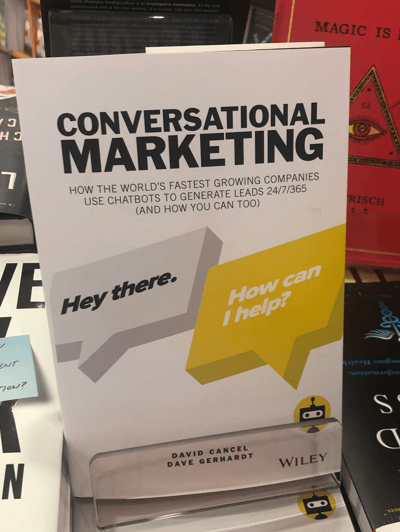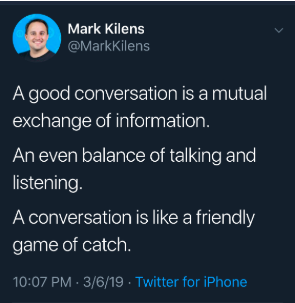 Conversational Marketing is a hot topic today. Whether you’re in a book store, in Times Square, following a bunch of marketers in a Twitter feed, or discussing with forward-leaning demand generation teams about where they’re focused today, conversational is sure to come up early.
Conversational Marketing is a hot topic today. Whether you’re in a book store, in Times Square, following a bunch of marketers in a Twitter feed, or discussing with forward-leaning demand generation teams about where they’re focused today, conversational is sure to come up early.
I will freely admit that I’m still a bit cynical about whether “conversational” is truly an emerging strategy or just another buzzword designed to make something simple and natural seem complex and difficult so the companies spreading the message can more easily sell their products and/or services (see branding).
I am increasingly being won over that conversation is a worthy topic of focus for growth-focused executives. I believe this for 3 reasons:
-
Demand generation, sales, and marketing are losing their plot and seem to be forgetting their fundamental purpose
-
Buyers continue to change their expectations and desires, and sellers must keep up and create alignment with the buyer
-
The growing focus and capabilities of technology seem to be having the unintended effect of disconnecting
To be clear, (capital C) Conversational Marketing must be viewed through a larger context than “chat,” chat applications, and chatbots. It must be viewed through the holistic prism of corporate strategy. Simply put, the time has come for your company to become a Conversational Company.
This blog post is focused on the key elements necessary to develop and execute such a strategy. It is not focused on the tactical/execution elements. If you’re looking for a great guide to implementing some of the tactics of around Conversational Marketing, I encourage you to download the resource that Drift just released designing The Conversational Blueprint. It’s a great resource and thinking document to guide how you approach conversations in your DemandGen process.
Serendipitously, as I began writing this post, Mark Kilens, Drift’s VP of Content & Community (and before that the leader of HubSpot Academy) tweeted this about conversations:
 The job of a Conversational Strategy is to design and execute the structure to generate “friendly games of catch” purposefully, predictably and repeatably.
The job of a Conversational Strategy is to design and execute the structure to generate “friendly games of catch” purposefully, predictably and repeatably.
1. Have a Defined, Documented Point-of-View
My mom taught me that if you don’t have something nice to say, then don’t say anything (and for those of you who know me well - I know what you’re thinking, and remember, just because my mom taught me doesn’t mean I learned it).
Increasingly I’m finding that the problem most companies are having isn’t that they don’t have anything nice to say, it’s that don’t have anything interesting or valuable to say.
I’ve literally lost count of the number of sales interactions I’ve had in the last two months (as a customer or prospect) where the customer experience (and the likelihood of a sale) would have been better if the salesperson hadn’t even been there (or at least just not said anything). A quick review of my Twitter and LinkedIn stream tells me I’m not the only one feeling this. But, I don’t blame this on the salespeople - I blame it on the senior leadership team.
If you want your salespeople to have strong interactions (and good conversations) consistently, then the business must establish and reinforce a clear, distinct point-of-view.
Download The Executive's Guide to Winning More Sales With Today's Modern Buyer
2. Align Your Customer Acquisition and Sales Process to Your Buyer’s Value Mode & Journey
Last week we were working with one of our clients helping them with their tech stack. We had recommended an app to add and they reached out directly to the company (they already had another product from them) to discuss it. After talking with the rep, our client told us that they were going to hold off moving forward with adding the app. We asked why. Long story short, the rep didn’t spend the time to understand the situation and what was needed to build the business case. They heard a single “hot button issue,” demo’d some of the razzle-dazzle, and offered a discount if they could move forward “before the end of the month.”
Now, this rep was friendly and one of the better reps at the company. The problem was that he was totally out of sync with where our client was in their journey.
Here again, I don’t blame the sales rep. I blame the organization and leadership for not setting up the structure and providing the training and resources necessary to have the right conversation at the right time with the right person in the right way.
3. Realize That All Content - Written, Visual, and/or Auditory - Is (Should Be) Conversational
Your customers’ definition of conversation is changing. Realize that every touch point is, in its own way, a conversation. Your home page, product page, pricing page, blog, videos, sales meetings, chats, emails, etc. all represent a conversation to your customer. Effective conversations flow and align with each other, ineffective ones do not.
If I have a chat with one person that is not aligned with your website messaging, previous sales conversations, collateral, or other chats then you’ve introduced invisible friction points. You create “message/signal conflict” which will introduce friction (at best) and reduce DemandGen and sales effectiveness.
4. Document A Conversation Style Guide
If you run a marketing team, you almost certainly have a brand style guide (and if you don’t then you’re certainly dealing with chaos). If you want to have strong conversations across the organization, you need to develop a Conversation Style Guide.
5. Develop Systems That Gather & Analyze Conversational Data From All Aspects of the Business
The great (and scary) thing about a conversational mindset is that conversations happen everywhere, all of the time. Every conversation is a data point, filled with the potential for insights and action.
Going forward, organizations must work toward gathering, tracking and analyzing all of this “conversational data” - wherever and whenever it happens.
Becoming a Conversational Company
We’re in the midst of what I refer to as the third major technology wave. I often find myself thinking back to the first wave when seeing the mistakes that companies and individuals are making around tech utilization. It was John Nesbitt, in the book MegaTrends who advised the winners of tomorrow (which I guess would mean today) would be the ones to embrace not only high tech but also high touch.
The ability to utilize technology to create stronger “high touch” points with greater consistency and frequency, at lower costs should be the objective of every company that’s serious about growth, or for that matter, sustainability in the future.
Whether you’re considering or using chat or not, if you ensure you’re proactively addressing the five points I share here, you’ll find your company being conversational and that will increasingly be the differentiating factor that enables you to win and keep quality business in the future.

 Doug Davidoff
Doug Davidoff